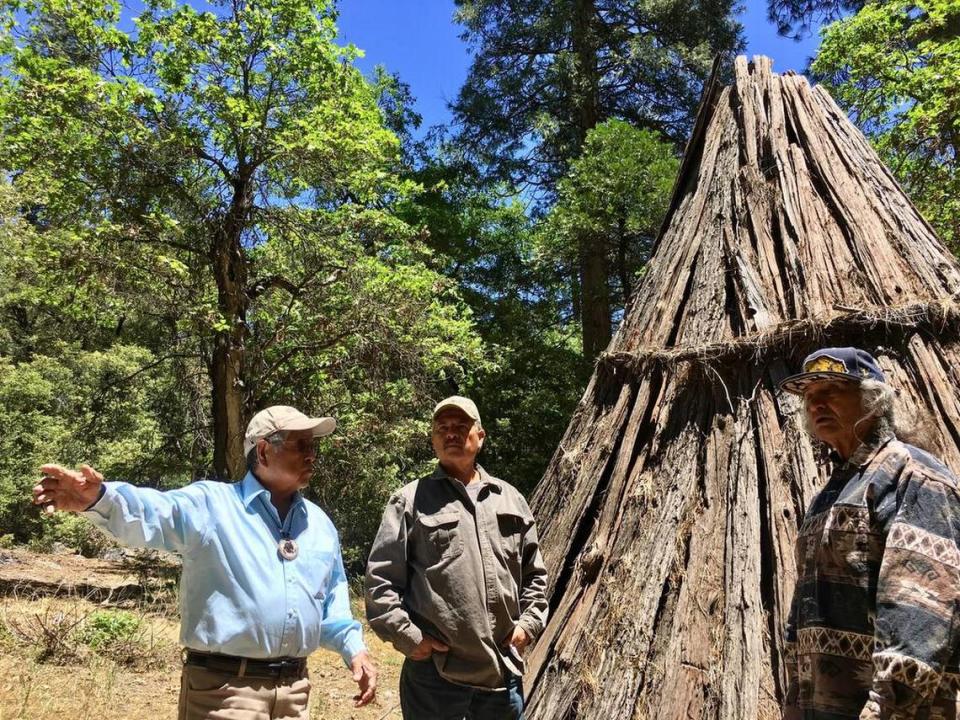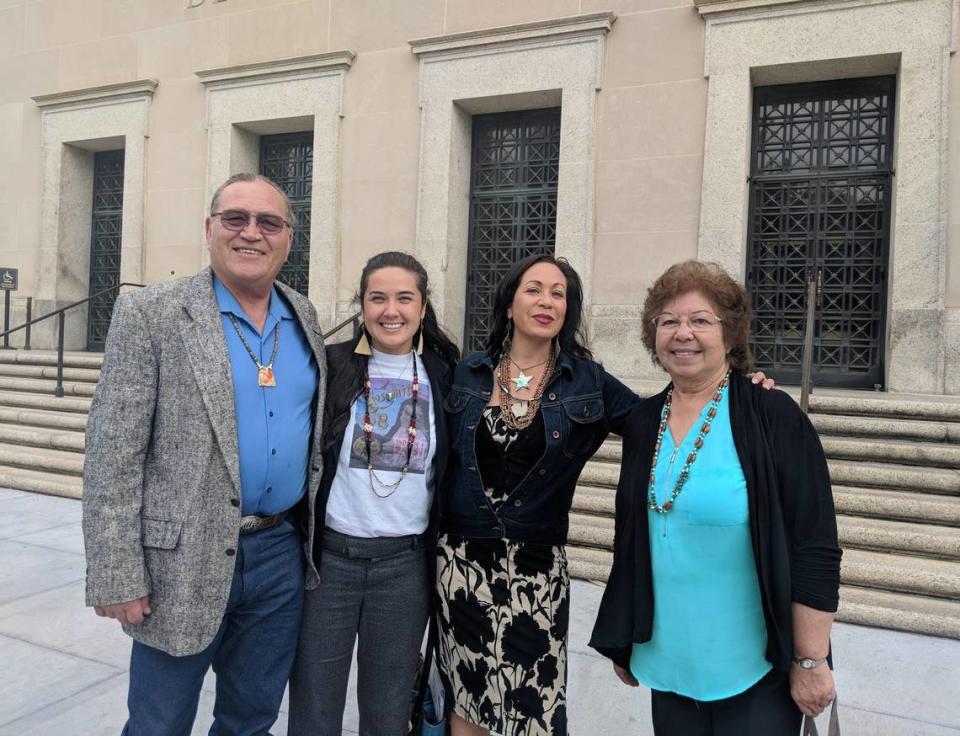‘The genocide has not stopped.’ Government recommends not recognizing Yosemite area tribe
The Southern Sierra Miwuk Nation has been waiting 37 years for a decision from the U.S. government about their petition for federal acknowledgment as a Native American tribe.
The California tribe with historic ties to Yosemite National Park and surrounding areas received bad news a year ago indicating a final decision denying them federal recognition could be near. A proposed finding with this recommendation was issued, looking at just one part of one of seven criteria, defining the tribe’s modern community.
It’s an unexpected finding, and an unexpectedly brief 25-page response, for the tribe which has submitted thousands of documents and endured decades of back-and-forth with the Office of Federal Acknowledgment.
A public comment period is underway. The deadline for submitting letters is Nov. 18.
The tribe requested an additional 180-day extension, supported by five members of Congress who recently wrote a letter noting “substantial concerns” with the process, including that the tribe hasn’t been given all the documents OFA reviewed to make its decision. As of Friday, the tribe hadn’t heard whether the extension to May 16 would be granted.
Among concerns is the tribe being evaluated under 1994 regulations instead of those revised in 2015, which many say are fairer to tribes.

Public comment letters so far include three from former OFA staff, who criticized the finding issued by Tara Sweeney, assistant secretary of Indian Affairs for the Department of the Interior.
At stake is access to assistance only provided to federally-recognized tribes, such as housing support, and the establishment of a government-to-government relationship with the U.S.
“We are still being destroyed as a people,” said Bill Leonard, Southern Sierra Miwuk Nation chairman. “They’re still killing us. In that way, the genocide has not stopped. … The genocide isn’t over as long as they’re denying tribes their rights.”
Federal acknowledgment is rare in California since the OFA was established in 1978. It’s happened just once in the state since then – in 1982 with the Death Valley Timbisha Shoshone tribe.
Traditional ties to Yosemite National Park
The Southern Sierra Miwuk Nation has a long relationship with Yosemite National Park, which officially recognizes the group as one of seven tribes with traditional ties to Yosemite.
The last Native American village in Yosemite Valley, named Wahhoga, is being rebuilt through the Southern Sierra Miwuk Nation’s nonprofit arm, the American Indian Council of Mariposa County, another name the tribe goes by.
While the National Park Service is under the Department of the Interior like the Office of Federal Acknowledgment, Yosemite officials said they are restricted from getting involved in the federal recognition process.
However, Yosemite spokesman Scott Gediman said the park views its relationship with the tribe – and the six others affiliated with Yosemite – as a government-to-government relationship.
“Native Americans have lived in and around the park for upwards of 8,000 years. … We greatly value and appreciate our relationships with tribes,” Gediman said, “and we thoroughly enjoy working with them.”
Many Southern Sierra Miwuk members now reside in nearby Mariposa County. The tribe’s traditional lands are in Mariposa County and parts of Merced and Madera counties, Leonard said.
Native Americans in Yosemite were killed and forced out of the park in the 1800s. Some were later allowed to live in Yosemite, working in the tourism industry. The park’s last native village, a cluster of cabins near the Camp 4 campground, was destroyed in segments by the Park Service and was completely removed by 1969.
Federal recognition would give the tribe the opportunity to find a tribal land base. Leonard said Yosemite Valley isn’t in question for that. Tribal members can’t reside in the Wahhoga village now under construction, which will only be used for traditional and educational purposes.
“Yosemite Valley, it’s already overcrowded,” Leonard said. “You have to think of future generations. You need enough land for housing and maybe some clinics to take care of elders and for economic development. Being in Yosemite Valley wouldn’t work for that.”
Tribal leaders frequently receive questions about Yosemite and Indian gaming. Leonard said gambling is not part of his motivation. The tribe applied for federal recognition in 1982, before the rise of large Native American casinos.
“It’s not about anything but justice for my ancestors – this is what I want people to know,” Leonard said. “I do this for my grandparents and great-grandparents and generations to come. And if it keeps taking longer, I may not live to be there when it happens.”
The tribe also voiced concerns about a Park Service plant gathering rule for traditional purposes that only addresses federally-recognized tribes.
“Ironically,” the tribe stated on their website, “the Yosemite Museum displays our tribal members making baskets, but our people are prohibited from gathering the basketry resources in the park necessary to continue this tribal tradition.”

Analyzing a Native American community
Some Southern Sierra Miwuk Nation leaders who worked to get the tribe federally recognized have died waiting, including tribal elder Jay Johnson.
The OFA finding against recognizing the tribe was based on criterion 83.7(b), that a “predominant portion of the petitioning group comprises a distinct community and has existed as a community from historical times until the present.”
“Due to the fact that the petitioner fails to meet the requirements of 83.7(b) (‘the present’), the Department considers it unnecessary to conduct an analysis whether a predominant portion of the group comprised a distinct community and existed as a community from historical times,” the finding reads. The “present” in this instance is 1982 to 2011.
Aldo Salerno, a historian with the Office of Federal Acknowledgment at the U.S. Department of the Interior from 2001 to 2017, said evaluating only one portion of one criteria is wrong.
In a letter to the office, Salerno said staff can’t know the tribe’s modern community “in any meaningful way” without also examining the group’s “historical tribe and community, politics, descent from the historical tribe, and identification from outside observers.”

Yet, the negative finding goes on to suggest more evidence is also needed to prove its historical tribe – despite the office also saying it felt it unnecessary to analyze the tribe’s history.
Salerno called this kind of vague advice “disingenuous and misleading.”
“For the Department to profess uncertainty about the historical Indian tribe this late in the process and yet still evaluate the group’s modern community is nothing short of bewildering. … It certainly should not require the SSM to do unnecessary research for answers it already has unless the petitioner disagrees with those conclusions,” Salerno wrote.
Another concern: The Southern Sierra Miwuk Nation is being evaluated under older regulations instead of revised ones that removed a requirement that a “predominant portion” of members comprise a community.
While the Southern Sierra Miwuk chose to still be evaluated under the older 1994 regulations, having first applied in 1982, Salerno wrote, “it was unclear to me while I was a member of the OFA that the group, or any group which chose the same option, understood the implications of that choice.
“Simply put, the AS-IA has established a two-tiered Federal acknowledgment process, one in which some older petitioners are unwittingly, arbitrarily, and capriciously being evaluated under a stricter and more burdensome standard of evidence than newer petitioners.”
Salerno called the office’s finding an “indefensible sham” in a column he wrote for Indianz.com.
“The Southern Sierra Miwuk are and always have been an Indian tribe,” he wrote. “The evidence I examined for the original positive recommendation clearly showed they were. I believed they deserved Federal recognition then, as did most of my OFA colleagues, and I believe that now.”
Gov. Gavin Newsom’s office has not responded to a request from the tribe for comment about the proposed finding. Leonard and the tribe’s attorney, Stephen Quesenberry, said that’s especially surprising in light of Newsom formally apologizing to Native Americans this summer on behalf of the state for California’s “dark history” of violence against indigenous people, and because a comment from the governor would be given special consideration as an interested party.
The OFA finding asks for better documentation of members at events, an updated membership list, and states family members visiting relatives doesn’t count as examples of community. Leonard estimates the tribe has around 700 members.
Southern Sierra Miwuk Nation events include bear dances, spiritual walks and spiritual camps in Yosemite, along with powwows and fundraisers. In one instance, the OFA report references tribal members attending a softball tournament in 1990, then states “it is not known how many members of the group went to cheer on their side, either on this occasion or others.”
Leonard said a lot of community interaction now happens via text messages and phone calls, since many tribal members had to move away from rural Mariposa County for work or historically, “so their children didn’t get taken to boarding school.”
In another instance, one page in the report quotes members talking about people recovering from alcoholism, then offers recommendations such as: “The petitioner may wish to provide additional information about how it enforces this prohibition (against using alcohol at spiritual events), and deals with any infractions, if they occur.”
Leonard and Quesenberry said they don’t understand why the OFA chose to highlight those statements out of extensive interviews, or what the office was getting at by referencing them in regards to community.
“To me, they were trying to say, ‘Indians are just a bunch of drunks. Here, we have proof,’” Leonard said.
The tribe renewed its request with the OFA last month that the proposed finding be withdrawn and that a new period of active consideration be started.
Quesenberry said former OFA review staff, who are no longer with the department, previously indicated a positive finding for the tribe was near before the government granted itself another review extension. He said the period of active consideration lasted nearly eight years when regulations stipulated it shouldn’t extend past 18 months.
The delays are expensive and burdensome for tribes, including the Southern Sierra Miwuk Nation, who have done much of their fundraising to pay for attorneys and researchers by doing things such as selling tacos at events and accepting donations via their website, southernsierramiwuknation.org.
“It’s not a process that’s very user-friendly,” Quesenberry said, “especially for small California tribes that are struggling just to maintain their culture and their existence.”
That existence is important to Leonard. He dreams of federal recognition also as a way to bring more of his people back home – “wanting to be able to have my children and grandchildren closer to me.”
“We just go day by day in that sense,” Leonard said of his 37-year wait for a federal recognition decision. “We maintain our ceremonies, that feeling of families and togetherness. That we support each other. Those are the things we can do now.”

